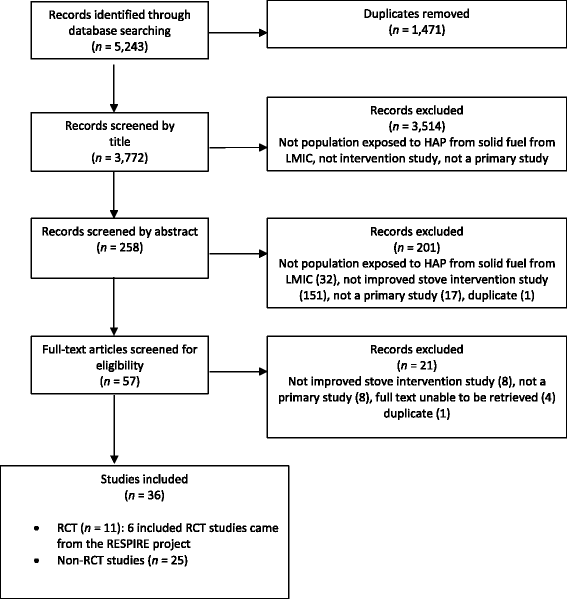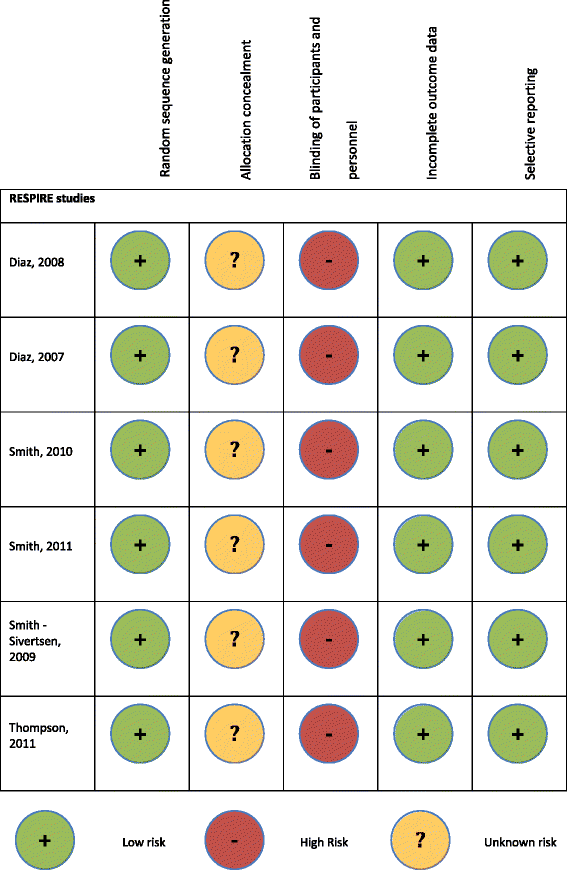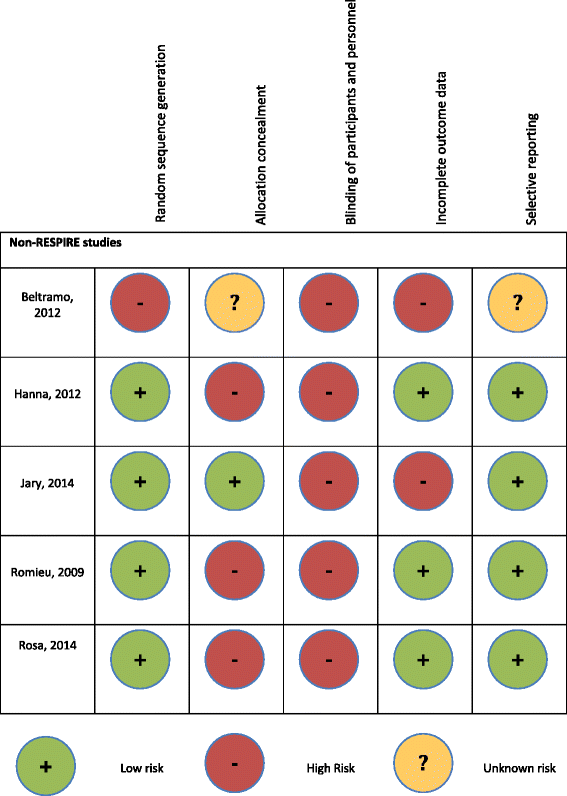Improved stove interventions to reduce household air pollution in low and middle income countries: a descriptive systematic review
- PMID: 26169364
- PMCID: PMC4499941
- DOI: 10.1186/s12889-015-2024-7
Improved stove interventions to reduce household air pollution in low and middle income countries: a descriptive systematic review
Abstract
Background: Household air pollution (HAP) resulting from the use of solid fuels presents a major public health hazard. Improved stoves have been offered as a potential tool to reduce exposure to HAP and improve health outcomes. Systematic information on stove interventions is limited.
Methods: We conducted a systematic review of the current evidence of improved stove interventions aimed at reducing HAP in real life settings. An extensive search of ten databases commenced in April 2014. In addition, we searched clinical trial registers and websites for unpublished studies and grey literature. Studies were included if they reported on an improved stove intervention aimed at reducing HAP resulting from solid fuel use in a low or middle-income country.
Results: The review identified 5,243 records. Of these, 258 abstracts and 57 full texts were reviewed and 36 studies identified which met the inclusion criteria. When well-designed, implemented and monitored, stove interventions can have positive effects. However, the impacts are unlikely to reduce pollutant levels to World Health Organization recommended levels. Additionally, many participants in the included studies continued to use traditional stoves either instead of, or in additional to, new improved options.
Conclusions: Current evidence suggests improved stove interventions can reduce exposure to HAP resulting from solid fuel smoke. Studies with longer follow-up periods are required to assess if pollutant reductions reported in the current literature are sustained over time. Adoption of new technologies is challenging and interventions must be tailored to the needs and preferences of the households of interest. Future studies require greater process evaluation to improve knowledge of implementation barriers and facilitators.
Review registration: The review was registered on Prospero (registration number CRD42014009796).
Figures


 signifying highest levels of disease burden to
signifying highest levels of disease burden to  signifying lowest levels of disease burden. This figure was created by the authors using ArcInfo 10.2.1
signifying lowest levels of disease burden. This figure was created by the authors using ArcInfo 10.2.1

Similar articles
-
Effectiveness of interventions to reduce household air pollution and/or improve health in homes using solid fuel in low-and-middle income countries: A systematic review and meta-analysis.Environ Int. 2017 Jun;103:73-90. doi: 10.1016/j.envint.2017.03.010. Epub 2017 Mar 22. Environ Int. 2017. PMID: 28341576
-
Electric fans for reducing adverse health impacts in heatwaves.Cochrane Database Syst Rev. 2012 Jul 11;2012(7):CD009888. doi: 10.1002/14651858.CD009888.pub2. Cochrane Database Syst Rev. 2012. PMID: 22786530 Free PMC article.
-
Education support services for improving school engagement and academic performance of children and adolescents with a chronic health condition.Cochrane Database Syst Rev. 2023 Feb 8;2(2):CD011538. doi: 10.1002/14651858.CD011538.pub2. Cochrane Database Syst Rev. 2023. PMID: 36752365 Free PMC article.
-
Clean fuels for resource-poor settings: A systematic review of barriers and enablers to adoption and sustained use.Environ Res. 2016 Apr;146:218-34. doi: 10.1016/j.envres.2016.01.002. Epub 2016 Jan 13. Environ Res. 2016. PMID: 26775003
-
Behavioral interventions to reduce risk for sexual transmission of HIV among men who have sex with men.Cochrane Database Syst Rev. 2008 Jul 16;(3):CD001230. doi: 10.1002/14651858.CD001230.pub2. Cochrane Database Syst Rev. 2008. PMID: 18646068
Cited by
-
Effectiveness of interventions to reduce household air pollution from solid biomass fuels and improve maternal and child health outcomes in low- and middle-income countries: a systematic review protocol.Syst Rev. 2021 Jan 20;10(1):33. doi: 10.1186/s13643-021-01590-z. Syst Rev. 2021. PMID: 33472668 Free PMC article.
-
Grassroots and Youth-Led Climate Solutions From The Gambia.Front Public Health. 2022 Apr 7;10:784915. doi: 10.3389/fpubh.2022.784915. eCollection 2022. Front Public Health. 2022. PMID: 35462834 Free PMC article. Review.
-
Implementing a context-driven awareness programme addressing household air pollution and tobacco: a FRESH AIR study.NPJ Prim Care Respir Med. 2020 Oct 6;30(1):42. doi: 10.1038/s41533-020-00201-z. NPJ Prim Care Respir Med. 2020. PMID: 33024125 Free PMC article.
-
Effectiveness of a home-environmental intervention package and an early child development intervention on child health and development in high-altitude rural communities in the Peruvian Andes: a cluster-randomised controlled trial.Infect Dis Poverty. 2022 Jun 6;11(1):66. doi: 10.1186/s40249-022-00985-x. Infect Dis Poverty. 2022. PMID: 35668472 Free PMC article. Clinical Trial.
-
Implementing lung health interventions in low- and middle-income countries: a FRESH AIR systematic review and meta-synthesis.Eur Respir J. 2020 Jul 23;56(1):2000127. doi: 10.1183/13993003.00127-2020. Print 2020 Jul. Eur Respir J. 2020. PMID: 32341109 Free PMC article.
References
-
- Smith K, Mehta S, Maeusezahl Feuz M. Indoor air pollution from household use of solid fuels, in Comparative quantification of health risks: global and regional burden of disease due to selected major risk factors. Trans R Soc Trop Med Hyg. 2004;102(9):843–51.
-
- Eisner MD, Balmes JR. Indoor and Outdoor Air Pollution. In: Mason RJ, Broaddus VC, Martin T, King T Jr, Schraufnagel D, Murray JF, Nadel JA, editors. Murray and Nadel’s Textbook of Respiratory Medicine: 2-Volume Set. 5. Philadelphia: Elsevier Health Sciences; 2010.
-
- Lim SS, Vos T, Flaxman AD, Danaei G, Shibuya K, Adair-Rohani H, et al. A comparative risk assessment of burden of disese and injury attributable to 67 risk factors and risk factor clusters in 21 regions, 1990–2010 : a systematic analysis for the Global Burden of Disease Study 2010. Lancet. 2012;380:2224–60. doi: 10.1016/S0140-6736(12)61766-8. - DOI - PMC - PubMed
Publication types
MeSH terms
Substances
Grants and funding
LinkOut - more resources
Full Text Sources
Other Literature Sources
Medical
Miscellaneous

